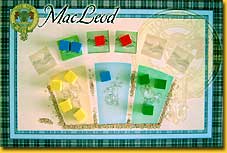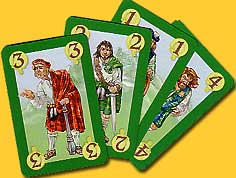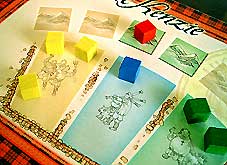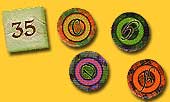MacRobber
Author: Ralf Burkert
Publisher: Queen Games
Year: 2005
review by

| x |
|
|
|
|
|
|
|
|
|
|
|
|
|
|
|
|
|
|
|
|
|
|
|
|
|
|
 |
The Scottish Highlands are inhabited by competing clans of log-throwing giants. It is not a very peace-loving society: the neighbouring clans rob and fight each other all the time. In MacRobber, we play clan chieftains that want to acquire name and fame in the Highlands. Their ways to accomplish this are not very subtle; cattle robbing and surprise attacks between the clans are frequently reoccurring phenomena!
Each player receives a board where he can place the possessions of his clan. On top, the estates are depicted; each clan starts with two estates, and he can expand his property to six estates. In his courtyards the player collects his warriors (yellow cubes), bagpipers (blue cubes) and monks (green cubes). Each player also receives four fighting cards with a value of 1 to 4.
|
| x |
|
|
|
|
|
|
|
|
|
|
|
|
|
|
|
|
|
|
|
|
|
|
|
|
|
|
|
A players’ turn starts with drawing six random cubes from the bag. These cubes can be used to perform two different actions out of eight:
•Place 1 cattle (red cube) on an unoccupied estate
•Place 1 castle (two blue cubes) on an unoccupied estate
•Place 1 monastery (three green cubes) on an unoccupied estate
•Place 1 warrior (yellow cube) in his courtyard. The number of fighting cards owned by a player should always equal the number of warriors in his courtyard; when he places a new warrior, he immediately draws an additional card
•Place 1 bagpiper (blue cube) in his courtyard
•Place 1 or 2 monks (1 or 2 green cubes) in his courtyard
•Purchase a new estate (1 yellow cube plus 1 red cube, or 1 yellow cube plus 2 green cubes). The player takes one estate from the stock and places it on his clan-board
•Play a bard (1 blue cube). The player may remove two differently coloured cubes from the courtyard of one opponent. He can put one of those cubes in his own courtyard, and the other one has to be returned to the stock.
|
|

 |
| x |
|
|
|
|
|
|
|
|
|
|
|
|
|
|
|
|
|
|
|
|
|
|
|
|
|
|
 |
|
He may not use more than four of the six cubes. If the player chose to play a bard, he cannot perform a second action.
Finally the player may conduct a raid against one opponent with his fighting cards. An raid consists of three rounds of combat; the player who wins most rounds of combat wins the raid.
If the attacker wins, he scores 1 victory point and he may destroy one castle or monastery from one of the defender’s estates, or he may steal a cattle and place it on one of his -unoccupied- estates. If the defender wins, he scores 2 victory points and the attacker loses 1 victory point. In the event of a tie, the attacker scores 1 victory point.
|
| x |
|
|
|
|
|
|
|
|
|
|
|
|
|
|
|
|
|
|
|
|
|
|
|
|
|
|
|
When all players have had a turn, scoring takes place. The player with the most yellow cubes gets a card that gives him the right to draw up to six new cubes from the bag during his turn if he is not satisfied with them. The player with the most green cubes scores 3 victory points, and the second place scores 2 points. All players score 1 point for each red cube, and the player with the most red cubes scores an additional 2 points. All players score 1 point for each blue cube, minus the number of red cubes of the opponent with the most cattle.
The game ends when less than six cubes remain in the bag, or when a blindly drawn chit has the same or lower value as the score of the leading player; that player wins immediately.
|
|
 |
|
|
|
|
|
|
|
|
 |
|
|
|
|
|
|
|
|


|
MacRobber is a nice game. Simple, and not too long: you play it within an hour. But the major drawback is that MacRobber is not much more than a lot of fiddling around with cubes. Warriors, monasteries, bards and monks: whatever you call it, it’s still about coloured cubes of which you must obtain more than your opponents. This makes the game extremely abstract: players are not really captured by the true Scottish Highland atmosphere, or by any kind of atmosphere at all, for that matter. Apart from that, there’s a great deal of luck involved in the drawing of the cubes. After a couple of turns the amount of red and yellow cubes in the bag is pretty much exhausted, and the choice is limited to blue or green. Many of the more interesting actions can then no longer be performed, so the only option you have is to put yet another bagpiper or monk in the courtyard…
In addition the outcome of the combat rounds is also a rather random happening. Altogether, this makes MacRobber a game with very limited tactical possibilities.
© 2005 Barbara Lussenburg
MacRobber, Ralf Burkert, Queen Games, 2005 - 3 to 5 players
|
  |
|
|
|
|
|
|
|
|
|
|
|
|
|
|
|
|
|
|
|
|
|
|
  |
|
|
|
|
|
|
|
|
|
|
|
|
|
|
|
|
|
|
|
|
|
|
  |
|
|
|
|
|
|
|
|
|
|
|
|
|
|
|
|
|
|
|
|
|
|
  |
|
|
|
|
|
|
|
|
|
|
|
|
|
|
|
|
|
|
|
|
|
|
|
|
| x |
|
|
|
|
|
|
|
|
|
|
|
|
|
|
|
|
|
|
|
|
|
|
|
|
|
|
| x |
|
|
|
|
|
|
|
|
|
|
|
|
|
|
|
|
|
|
|
|
|
|
|
|
|
|
 |
|
|
|
|
|
|
|
|
|
|
|
|
|
|
|
|
|
|
|
|
|
|
 |
|
|
|
|
|
|
|
|
|
|
|
|
|
|
|
|
|
|
|
|
|
|
| x |
|
|
|
|
|
|
|
|
|
|
|
|
|
|
|
|
|
|
|
|
|
|
|
|
|
|
 |
|
|
|
|
|
|
|
|
|
|
|
|
|
|
|
|
 |
|
|
|
|
|
|
|
|
|
|
|
|
|
|
|
|
|
|